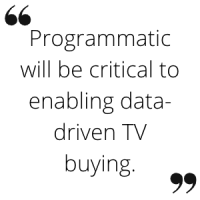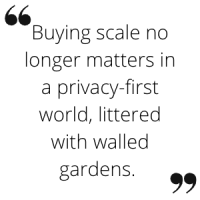Industry Review 2022: Moving Away from Legacy Infrastructure
by Ciaran O'Kane on 20th Apr 2022 in News

Our industry is in a state of flux. From regulatory oversight, to increased platform privacy functionality, to the proliferation of the walled garden, the entire ecosystem is still trying to get to grips with a rapidly changing media and marketing landscape.
For my review of the industry this year I am going to focus on six pillars that will concentrate minds. I believe these pillars represent the best opportunities, and will be the focus of most innovation and investment for the coming 12 months.
1. The fate of the open web
The first - and probably most critical - is the fate of the open web. With third-party cookies and ID deprecation, can we find functional replacements for existing targeting and measurement? Can contextual, clean rooms, and a move to ‘attention’ measurement save the open web?
The realities of the ‘shrinking’ open web were brought home to me by a product lead recently, when he pointed out that a sizeable minority (30%-40%) of Chrome users are either browsing in ‘incognito’ mode or have the strongest DNT (do not track) settings in place. That means that over 40% of the addressable web has already gone.
We currently operate in an addressable marketplace that is becoming less addressable by the day. Thankfully, we are seeing offerings and strategies emerging that are tackling some of these underlying problems.
The open web will have a good future post third-party cookie. But it’s going to look a lot different from today. I believe the building blocks for a successful open web need to be built on a privacy-first approach - and that’s why we will see a big focus on technologies evolving beyond ID hacking.
2. The growth opportunity in retail media
 Retail media is another big growth area. It is a ten-year-in-the-making ad market. It has taken the rise of e-commerce, shifting trade budgets, and the explosive growth of Amazon's ad business for online retailers, marketplaces, tech vendors and buyers to invest resources into the area.
Retail media is another big growth area. It is a ten-year-in-the-making ad market. It has taken the rise of e-commerce, shifting trade budgets, and the explosive growth of Amazon's ad business for online retailers, marketplaces, tech vendors and buyers to invest resources into the area.
We will see hundreds and thousands of online retailers and marketplaces building retail media businesses, trying to tap a new margin-heavy revenue source.
The multi-billion dollar/euro/pound channel emerging in retail media now seems to be on everyone’s radar. Retail media accesses a whole new source of ad spend - namely traditional trade budget spend that sat with large retailers.
Buyers will be attracted by changing user behaviour and the tight attribution model offered by the channel. Ad tech will be necessary for aggregation, execution, segmentation, format innovation and addressability.
3. Making data-driven TV addressable to buyers
The third pillar is data-driven TV. There is so much TV inventory locked in walled gardens outside the US. How do you make the BVOD, AVOD, FAST et al addressable to buyers?
The sheer number of siloed TV inventory sources makes it especially difficult to scale targeting and measurement. It will be interesting to see how data-driven focused buyers aggregate and optimise in this challenged environment.
Programmatic will be critical to enabling data-driven buying. But so too will new aggregator platforms, as marketers try to knit together disparate pockets of TV ad inventory.
Contextual will be the go-to for targeting, as buyers seek out greater granularity. Increased privacy concerns around the use of IP will see a bigger adoption of 'evolved' panel solutions.
Data-driven TV buying outside the US is very difficult; it is underpinned by legacy buying practices and slow tech adoption. But this evolving USD$200bn ad market will offer huge opportunity.
4. Increased fragmentation in gaming
Gaming, our fourth pillar, continues to grow in importance. The rise of the gaming platform (gaming content + ad tech) will not consolidate the channel. Instead it will increase fragmentation. Who will join the dots for publishers on monetisation, but also deliver ROI for buyers? You guessed it, ad tech.
 Gaming-as-a-channel is finally attracting greater marketing spend. Marketers finally recognise the sizeable chunk of the attention economy that gaming now commands. Deprecation of mobile IDs obviously complicates attribution. But this industry always finds a way to innovate.
Gaming-as-a-channel is finally attracting greater marketing spend. Marketers finally recognise the sizeable chunk of the attention economy that gaming now commands. Deprecation of mobile IDs obviously complicates attribution. But this industry always finds a way to innovate.
Incessant hype around the 'metaverse' will pull more marketers into space. The concept of the metaverse is not new. Gaming is already the hook for existing metaverses (such as Fortnite and Roblox). I see in-game advertising acting as the 'brand bridge' into these new gaming worlds. Doubtless, more innovation will follow as ad tech dreams of new formats and data-driven functionality.
5. Growing walled gardens
The fifth pillar looks at the impact of walled garden growth. While some might bemoan this development, there will be huge upside for the service and tech layer - as buyers look to vendors for execution, optimisation and measurement capabilities.
Media is now a series of walled gardens. Simple tasks like frequency capping and basic optimisation will become more difficult. We need to re-imagine how we do marketing in the privacy-first era.
6. The evolution of the service layer
The sixth and final pillar will focus on the evolution of the service layer. The service layer becomes even more important as the media landscape splinters. Buying scale no longer matters in a privacy-first world, littered with walled gardens.
 Agency partners will instead be benchmarked on their planning expertise, data management and execution capabilities, and the ability to piece together disparate technology.
Agency partners will instead be benchmarked on their planning expertise, data management and execution capabilities, and the ability to piece together disparate technology.
New service solutions will emerge to plug knowledge gaps around data management, technology selection and implementation, and channel expertise (Amazon, TikTok etc). The increased complexity means more specialism is required.
Ad networks will return to the fore to aggregate and optimise open web audiences and emerging channels like retail media. Some will see this as a backward step, but it will be necessary with so many audience blind spots.
The industry review provides ExchangeWire's view of the market, and the emerging trends. We firmly believe we are about to enter an extended innovation cycle, moving away from legacy infrastructure that can no longer deliver for buyers and sellers.
The year 2022 will represent the beginning of that transition, opening up exciting opportunities for those vendors building truly innovative technology that has proper utility in a world where walled gardens and privacy underpin the new reality.
Ad NetworkAgenciesAVODCTVDataE-CommerceFirst-Party DataGamingIdentityRetail MediaTV








Follow ExchangeWire